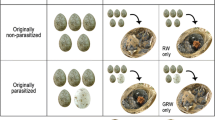Abstract
A cuckoo Cuculus canorus dummy was exposed at 24 nests of great reed warbler Acrocephalus arundinaceus (GRW) and 34 nests of reed warbler Acrocephalus scirpaceus (RW) during the egg-laying stage. The eight GRW pairs attacked the cuckoo directly, striking the dummy, but such a behaviour was not recorded in RWs. Also, other behavioural measures (closest distance from the model, duration of distress calls and number of excitement calls) indicated a lower level of defence by RWs compared to GRWs. In the study area, the parasitism rate was much lower in GRWs (1.7% of nests) than in RWs (11.3%). We suggest that one of the reasons for the lower level of cuckoo parasitism on GRWs is its stronger nest defence and hence higher risk of injury or even death for the cuckoo during egg dumping.
Similar content being viewed by others
References
Bartol I, Karcza Z, Moskat C, Roskaft E, Kisbenedek T (2002) Responses of great reed warblers Acrocephalus arundinaceus to experimental brood parasitism: the effects of a cuckoo Cuculus canorus dummy and egg mimicry. J Avian Biol 33:420–425
Cramp S (1992) Birds of the Western Palearctic, vol 6. Oxford University Press, Oxford
Davies NB (2000) Cuckoos, cowbirds and other cheats. Poyser, London
Davies NB, Brooke ML (1988) Cuckoos versus reed warblers: adaptations and counteradaptations. Anim Behav 36:262–284
Davies NB, Butchart SHM, Burke TA, Chaline N, Stewart IRK (2003) Reed warblers guard against cuckoos and cuckoldry. Anim Behav 65:285–295
Duckworth JW (1991) Responses of breeding Reed Warblers Acrocephalus scirpaceus to mounts of sparrowhawk Accipiter nisus, Cukoo Cuculus canorus and Jay Garrulus glandarius. Ibis 133:68–74
Dyrcz A, Halupka K (in press) Differences in patterns of alien eggs rejection in sympatric populations of the Great Reed Warbler Acrocephalus arundinaceus and Reed Warbler A. scirpaceus parasited by the Cuckoo Cuculus canorus. Ethology
Gibbs HL, Sorenson MD, Marchetti K, Brooke ML, Davies NB, Nakamura H (2000) Genetic evidence for female host-specific races of the common cuckoo. Nature 407:183–186
Kleven O, Moksnes A, Roskaft E, Honza M (1999) Host species affects the growth rate of Cuckoo (Cuculus canorus) chicks. Behav Ecol Sociobiol 47:41–46
Moksnes A, Roskaft E, Bicik V, Honza M, Oien IJ (1993) Cuckoo Cuculus canorus parasitism on Acrocephalus warblers in southern Moravia in the Czech Republic. J Ornithol 134:425–434
Moksnes A, Roskaft E, Braa AT, Korsnes L, Lampe HM, Pedersen HC (1991) Behavioural responses of potential hosts towards artificial cuckoo eggs and dummies. Behaviour 116:64–89
Moksnes A, Roskaft E, Hagen LG, Honza M, Mork C, Olsen PH (2000) Common Cuckoo Cuculus canorus and host behaviour at Reed Warbler Acrocephalus scirpaceus nests. Ibis 142:247–258
Moskat C, Honza M (2002) European Cuckoo Cuculus canorus parasitism and host’s rejection behaviour in a heavily parasitized Great Reed Warbler Acrocephalus arundinaceus population. Ibis 144:614–622
Roskaft E, Moksnes A, Bicik V, Moskat C (2002) Aggression to dummy cuckoos by potential European cuckoo hosts. Behaviour 139:613–628
Acknowledgments
We thank Wanda Zdunek and Zbigniew Pietrzak for field assistance. We are grateful to the anonymous referee for constructive comments. We appreciate financial support from the Polish State Committee for Scientific Research, grant no. 4675/PB/IZ/02. The research was approved by the local Ethical Commission. We declare that the experiments comply with the current laws of Poland.
Author information
Authors and Affiliations
Corresponding author
Additional information
Communicated by F. Bairlein
Rights and permissions
About this article
Cite this article
Dyrcz, A., Hałupka, L. Great reed warbler Acrocephalus arundinaceus and reed warbler Acrocephalus scirpaceus respond differently to cuckoo dummy at the nest. J Ornithol 147, 649–652 (2006). https://doi.org/10.1007/s10336-006-0097-x
Received:
Revised:
Accepted:
Published:
Issue Date:
DOI: https://doi.org/10.1007/s10336-006-0097-x




